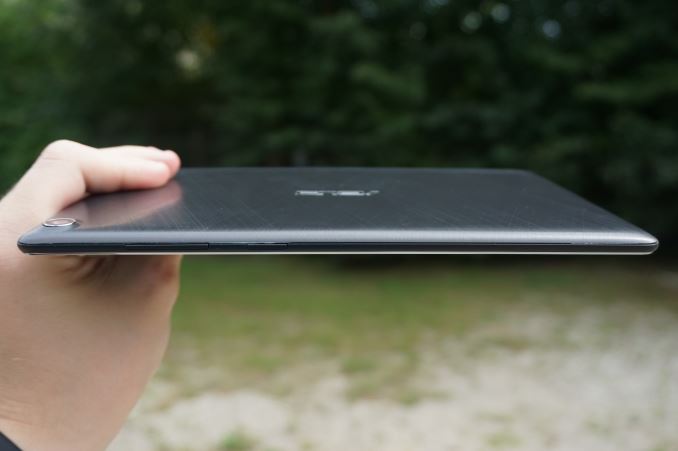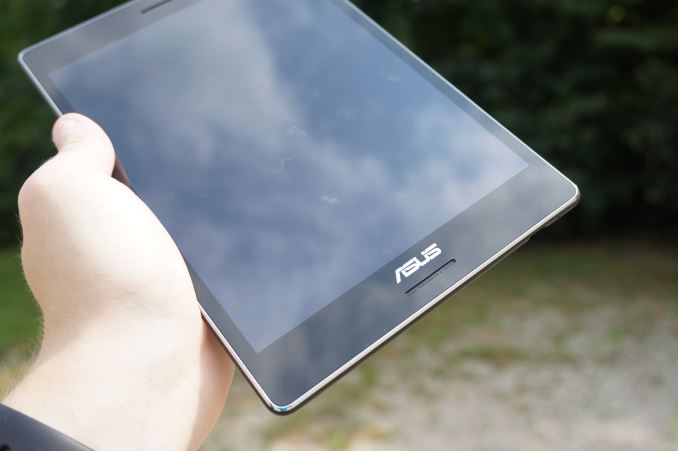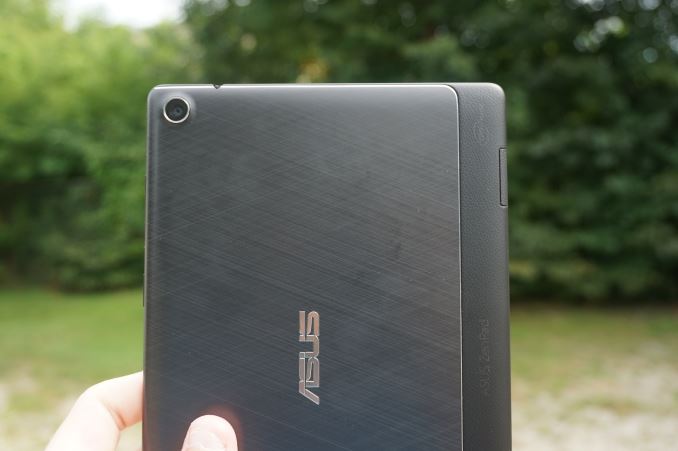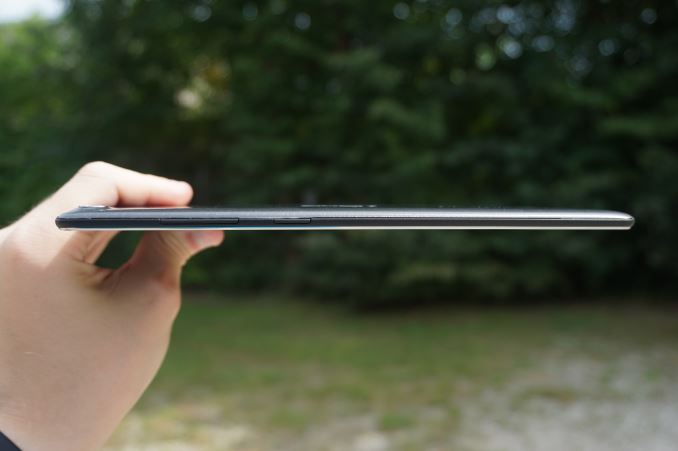The ASUS ZenPad S (Z580CA) Review
by Brandon Chester on August 31, 2015 8:00 AM ESTDesign
In my mind, I think of the ZenPad S Z580CA as a companion to the ZenFone 2. Both devices have an affordable price, and you can really buy both of them and still end up spending less than you would on a flagship smartphone. While they definitely share a UI and many internal hardware components, there isn't much similarity between the external design and construction of the two devices.
The first thing you'll notice when you pick up the ZenPad S isn't how the materials feel, but how incredibly thin and light the entire device feels. It's 6.6mm thick at its thinnest point, and the thickest point is only a small fraction of a millimeter thicker than that. Its mass is only 298g, which makes it the lightest tablet I've looked at to date. While it's not as thin as the iPad Air 2 or the Dell Venue 8 7840, the thickness and mass work together to give a feeling of lightness and portability that I've only ever experienced with one other device, which was the original iPad Mini.
There's not much to say about the front of the ZenPad S. Like all tablets, it's just a big display. ASUS has made space for two front-facing stereo speakers, which is something you won't get on an iPad or on the Galaxy Tab S2. As for the quality of the speakers, my highly subjective evaluation is that they are better than the iPad Air 2, and much better than the Nexus 9. They also don't cause significant chassis vibration despite the tablet's small thickness, which is something the iPad Air 2 suffers from.
Surrounding the edge of the ZenPad's front bezels is a metallic looking silver edge. This is really made of plastic, and like the plastic construction of the ZenFone 2 I'm a bit concerned about its durability. Readers may remember that a single fall from an extremely short height ended up scuffing up the back cover of our ZenFone 2 pretty badly. With the ZenPad S I have made sure to be quite careful, and haven't dropped it or hit it off anything to the best of my knowledge. Even so, there are some small dents in the silver edge. Pressing on it confirms that it's a fairly soft plastic, and I feel like it's going to be a magnet for these types of small dents and marks. In contrast, the Nexus 9 and iPad Air 2 testing units I have could probably be packaged and sold as brand new despite having them in my possession for significantly longer than the ZenPad S. If someone intends to use the ZenPad S as a tablet they can throw into their bag with other objects I would definitely be aware of the potential for damage to the edge.
The back of the ZenPad S is split into two sections. The smaller section has a soft touch feeling, and almost feels a bit like the pleather some phone cases are made of as it has a texture to it. This section is slightly thinner than the rest of the back cover, and it houses the tablet's MicroSD slot. What's interesting is that this part blends smoothly into the sides of the tablet, even though the sides have a distinctly different feeling due to their lack of texture. The soft touch part of the tablet also has the tablet's name and the Intel logo on it. However, it rubs off fairly easily as you can see in the image above, and at the time of writing this paragraph the logos have come off entirely.
The second part of the ZenPad back cover is a large plastic panel. In my review of the ZenFone 2 I said that the back cover of the phone did a good job of mimicking the appearance of aluminum, but felt entirely like plastic. The plastic segment of the ZenPad's back cover could actually convince you that it's made of metal unless you have the urge to tap on it. Like the ZenFone 2, the ZenPad's back cover has a shine to it that looks very much like the reflections made by brushed aluminum, although in the ZenPad's case the back cover has a pattern of overlapping diagonal lines rather than the straight lines of the ZenFone 2. Unfortunately, the hard plastic part of the back cover doesn't give any illusion of the tablet itself being made of metal, as you'll always be touching the soft touch plastic of the sides and the smaller segment of the back.
Right out of the box, my ZenPad S review unit did seem to have some issues with the hard plastic segment of the back cover that I think should have been picked up during QA. As you can see in the images above, there are areas on the edge of the plastic that are warped in such a way that they are no longer smooth like the other sections. It looks like these areas weren't finished properly, and when you look at the tablet from the side you can see that the entire edge around the power button and volume rocker is improperly formed and doesn't have the same color as the rest.
Ultimately I think the ZenPad S does a good job at being what it is, which is a tablet with a plastic chassis. My big concern is that the iPad Mini 2 sits at exactly the same price, and offers a completely aluminum chassis that feels much higher quality and will likely not incur the damage I've seen on the ZenPad's edge and back cover. The iPad is obviously heavier and thicker though, and the only way to achieve the low mass that the ZenPad S has is with plastic.
Personally, I think if I was given the choice I would opt for a slightly thicker and heavier device made of aluminum or a more durable plastic than a thinner and more easily damaged plastic one. The thicker device also has the benefit of storing a larger battery. Other people may value the thinness and the lightness more, particularly with 8" tablets which are more likely to be kept on someone's person than larger tablets. In the end everything is a series of trade-offs, and it's important to think about what aspects of design and build quality matter most to you when considering which tablets to buy.














114 Comments
View All Comments
MrSavage - Monday, August 31, 2015 - link
Aside from possibly mentioning the stylus support in the review. I would imagine with that logic, you would assume the S Pen is no biggie when it comes to the Samsung Note. Like just a passing point. It's not like the note taking is a selling point (a big one at that) of the Note series. But in this tablet review, your readers wouldn't even know it existed. I guess you decide on what's the responsible way of reporting on a product.Kepe - Monday, August 31, 2015 - link
The difference is that a Galaxy Note always comes with the pen. How could you review something you don't have? If ASUS had sent him the stylus, he would've written about it. You can't possibly assume that a review mentions every optional extra there is available for a device. "Oooh, your laptop review sucks because you didn't mention the carrying bag or the Kensington lock available for that laptop!!"MrSavage - Monday, August 31, 2015 - link
Friend, again, the point is what? A stylus is a BIG VALUE ADD. No? I give you the example of the Samsung Note to prove that it's a big selling point. To have that feature in the Z580CA yet not have it mentioned it actually irresponsible. You speak of it like it's some smart case that wasn't available at the time of publishing. Optional extra? LOL. List 8-inch tablet with stylus support. Then narrow that list down to similarly priced tablets. None? Right. Leave it out of the review because stylus is just so meh. You are dazzled by charts and graphs that compare apple with oranges and are willing to see a graph to make a determination on screen quality rather than going into a store and looking for yourself.Kepe - Monday, August 31, 2015 - link
omg. Now you're saying a stylus doesn't add value to the product. Then why are you crying about stylus support not being mentioned in the review?And the thing with screen quality is that it is all about accurate color reproduction. So if there is a faintly red flower in a photo, it should look faintly red on your display. If it looks like a hot super bright red flower on a display, then that display is not accurate and isn't good. Even if it makes some things "look" better. Samsung Galaxy S3 for example. Pictures look super pretty on its display. You know why? The display oversaturates everything, and as such it is actually not accurate and not a good display. If you personally like to look at oversaturated things, then buy the SGS3, no one is stopping you. BUT the fact still remains that the display isn't accurate. This was of course just an example. Some things can't be quantified by just looking at it or feeling it somehow.
And this is my last reply to you. Hope ASUS pays you well. Have a good night with your mediocre, badly made tablet. Thanks to the review, I will look elsewhere if and when I need a new tablet.
superflex - Monday, August 31, 2015 - link
Is ASUS paying you in Hot Pockets?You're a pretty poor troll.
MrSavage - Monday, August 31, 2015 - link
@superflex if you care to debate any of the points I'm making, go ahead. I likely know more about the product than most, so I'm going to inform people and hope that people with a large audience will be responsible. If for nothing more than being professional. Like I said, you think I'm wrong about anything I've said in the comments, please advise me. I have a thick skin. People might have learned that the Z580CA has stylus support, so to say that makes me a troll? I only take issue with unprofessional.Winterblade - Monday, August 31, 2015 - link
Is just sad that everyone just forgot another great alternative, the Xperia Tablet Compact, too sad it came dead on arrival due it's high price, I actually found one in clearance for about $230 USD and could not be happier, the build quality is superb, the performance is too, it was even updated to 5.1.1 within the first few hours I had it. If only Sony had managed to sell it for around 300-350 I think it would have been a very very good alternative for people that like mid sized tablets. BTW, the Z3 have an aluminum frame AND is lighter AND thinner than the Zenpad so... it is posible to achieve a lighter device without going full plastic.DanNeely - Monday, August 31, 2015 - link
Sony has a negligible presence in the US market; and their longstanding refusal to provide review samples more or less guarantees their largely being ignored by the US tech press.They make above average hardware; but it doesn't matter to me. I'll be carrying my grudge against them over the rootkit to the grave.
et20 - Monday, August 31, 2015 - link
Thank you for the review.This tablet looked interesting and there's nothing like an Anandtech review to clarify things.
I was interested in the cheaper model so I had proportionately low expectations, but the poor screen calibration is a deal breaker. Too bad.
MonkeyPaw - Monday, August 31, 2015 - link
As a bit of feedback, I think better pictures of the products are needed in these reviews. As I look at these photos, I just can't help but think of someone awkwardly holding a tablet out with one hand while trying to photograph it with the other. I know not everyone is a photographer, but good, clean, properly lit product shots go a long way for a professional look. Make a little product photo booth out of white paperboard/foamcore and mount a camera on a tripod for flashless photography.